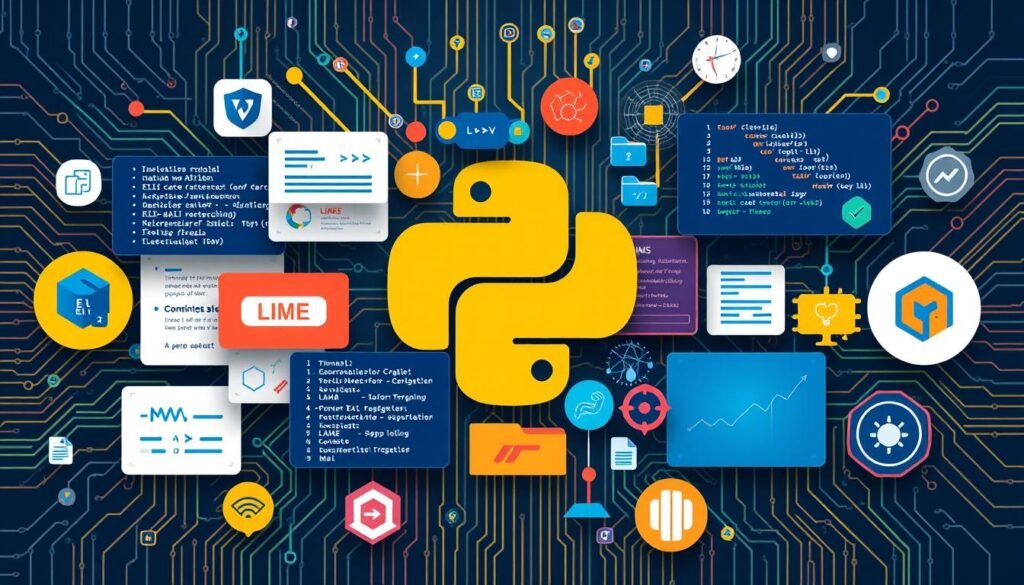A surprising 92% of sentences can be seen as hate speech with the BERT model. This shows why we need explainable ai (xai) to understand AI’s decisions. As you explore machine learning, you’ll see how important it is to make models clear and easy to understand. In this GeeksForGeeks tutorial, you’ll learn about explainable ai (xai) using python. You’ll also see how to make machine learning models more trustworthy and easy to understand.

AI is becoming a big part of our lives, and it’s more important than ever to be clear about how it works. Explainable ai (xai) helps machine learning algorithms make decisions that humans can understand and trust. By using python and xai, you can make models that are clear and reliable. This is great for anyone working with data, developing AI, or just interested in AI.
Key Takeaways
- Explainable AI (XAI) refers to a collection of procedures enabling machine learning algorithms to produce output understandable and reliable for human users.
- Transparency, interpretability, and accountability are core principles of Explainable AI (XAI).
- XAI aims to create more understandable models while maintaining high learning performance.
- Python is a popular language used for implementing XAI.
- GeeksForGeeks provides a comprehensive guide on Explainable AI (XAI) in Python.
- XAI is essential for understanding the ‘why’ behind AI decisions, especially in critical areas like getting a loan or diagnosing diseases.
- Different approaches within XAI, like feature importance, attribution, and visualization, aim to provide more transparent and interpretable machine learning models.
Understanding Explainable AI (XAI): Core Concepts
Exploring Explainable AI (XAI) means understanding its unique aspects. Unlike traditional AI, XAI is clear and easy to understand. It’s about making AI models transparent, not mysterious “black boxes.”
Key parts of XAI include feature importance and how to interpret models. Explanation algorithms are also crucial. These elements help us see how AI makes decisions.
A tutorial on XAI wouldn’t be complete without talking about interpretability. Techniques like LIME help models explain their choices. This is vital in areas like healthcare and finance, where clear decisions are essential.
With python programming, you can make XAI models that are both accurate and clear. This is great for building trust and making better decisions.
Some main advantages of XAI are:
- Improved decision-making
- Increased trust and acceptance
- Reduced risks and liabilities
These benefits come from using explanation algorithms and understanding model behavior. By grasping these basics, you’re ready to apply XAI in your projects. You’ll create models that are open, clear, and reliable.
Next, you’ll learn how to prepare your Python environment for XAI. You’ll start building models that are not just right but also clear and trustworthy.
Setting Up Your Python Environment for XAI
To start working with explainable ai, you need to set up your python environment. This involves installing the necessary libraries and tools, such as LIME and SHAP. These are popular XAI frameworks. You can install these libraries using pip, the python package manager. For example, you can install LIME using the command pip install lime.
A tutorial on setting up your python environment for XAI can be found on various online platforms, including GeeksForGeeks. These tutorials provide step-by-step instructions on how to install the necessary libraries and configure your development environment. They also provide code examples to help you get started with XAI development.
Some of the key concepts you will learn in these tutorials include model interpretability, local interpretable model-agnostic explanations, and feature importance. You will also learn how to use these concepts to implement XAI techniques in your python code. With the help of these tutorials and code examples, you can set up your python environment for XAI and start building your own XAI models.
Here are some steps to follow when setting up your python environment for XAI:
- Install the necessary libraries, such as LIME and SHAP
- Configure your development environment
- Learn key concepts, such as model interpretability and feature importance
- Practice implementing XAI techniques using code examples
By following these steps, you can set up your python environment for XAI and start building your own XAI models. With the help of tutorials, code examples, and practice, you can become proficient in XAI development. Then, you can start applying these techniques to real-world problems.
Popular XAI Libraries and Tools in Python
Exploring Explainable AI (XAI) opens up a world of libraries and tools. These help you make your machine learning models more understandable. On GeeksForGeeks, you can find many resources and tutorials on using Python for XAI. Here, we’ll look at some top Python XAI libraries and tools to help you understand your models’ predictions.
For XAI, machine learning experts often use LIME, SHAP, and Eli5. These libraries offer features to understand how models predict outcomes. For example, LIME helps explain any machine learning classifier’s predictions. SHAP uses game theory to explain any model’s output.
LIME (Local Interpretable Model-agnostic Explanations)
LIME is a key XAI method for explaining any machine learning classifier’s predictions. It has a big user base thanks to its open-source API in R and Python. LIME helps you understand how your models decide by explaining their predictions.
SHAP (SHapley Additive exPlanations)
SHAP is another top XAI library that uses game theory to explain any model’s output. It assigns a value to each feature for a specific prediction, showing its contribution. This helps you see how your models predict and which features are key.
Eli5 Library Overview
The Eli5 library offers a unified API for debugging and explaining machine learning classifiers. It makes it easy to explain your models’ predictions and find the most important features. It’s great for machine learning pros who want to understand their models’ decisions.
InterpretML Framework
The InterpretML framework brings together various machine learning interpretability techniques. It helps you understand your models’ predictions and find the most important features. It’s especially useful for XAI in fields like manufacturing and social science research.

By using these popular Python XAI libraries and tools, you can easily explain your machine learning models’ predictions. Whether you’re working on machine learning or XAI projects, these tools will help you achieve interpretability and understand your models’ decisions.
| XAI Library/Tool | Description |
|---|---|
| LIME | Local Interpretable Model-agnostic Explanations |
| SHAP | SHapley Additive exPlanations |
| Eli5 | Unified API for debugging machine learning classifiers |
| InterpretML | Collection of machine learning interpretability techniques |
Implementing Explainable AI XAI GeeksForGeeks in Python: Step-by-Step Guide
Now you know why explainable AI is key in machine learning. It’s time to apply this knowledge. We’ll show you how to use XAI in Python with real examples. You’ll learn to build your first XAI model and add explainability to your machine learning projects.
LIME is a library that helps explain your model’s decisions. It creates 5000 samples around the instance being explained. Then, it uses these samples to show which inputs are most important for predictions.
Building Your First XAI Model
First, install scikit-learn and lime. Then, start building your XAI model with GeeksForGeeks’ code examples. These will help you create a simple XAI model and understand its results.

Feature Importance Visualization
Seeing how important each feature is is key. Use partial dependence plots and SHAP values to see which features matter most. With explainable AI xai geeksforgeeks in python, you can make interactive visualizations. This helps you see how features affect predictions.
| Technique | Description |
|---|---|
| Partial Dependence Plots | Shows the relationship between a specific feature and the predicted outcome |
| SHAP Values | Assigns a value to each feature for a specific prediction, indicating its contribution to the outcome |
By following these steps and using GeeksForGeeks’ code, you can implement explainable AI in Python. This will help you understand your machine learning models better. Always aim for transparency and interpretability in your models. And don’t stop exploring new techniques and tools in explainable AI.
Best Practices for XAI Implementation
Exploring explainable ai (xai) is exciting, but knowing how to implement it is key. When using python, picking the right method for your project is crucial. It’s about finding a balance between understanding the model and how well it works. Tutorials can help a lot in making your models clear and reliable.
Here are some important things to think about when using xai:
- Choosing the right evaluation metrics, such as precision, recall, and F1 scores, to assess your model’s performance
- Addressing challenges like data quality and bias, model complexity, and scalability issues
- Implementing strategies for presenting xai results to both technical and non-technical audiences
By following these best practices, you can make ai systems that are not just strong but also trustworthy and fair.
The main aim of xai is to shed light on how your model makes decisions. It’s a vital tool for anyone in machine learning or deep learning. With the right strategy and a focus on openness, you can fully harness xai’s power and advance your ai projects.
Conclusion: Future of Explainable AI and Next Steps
Throughout this guide, you’ve learned about explainable AI (XAI). It’s changing how we use machine learning. AI is now in key decisions, making it vital to be open and accountable. The future of XAI looks bright, with new discoveries on the horizon.
Improving how we understand AI models is a big focus. Tools like LIME and SHAP have helped a lot. But, we need better ways to show how models work. As AI gets smarter, we’ll need clearer ways to explain it.
Also, combining XAI with new tech like reinforcement learning will be exciting. This mix will make AI more open and reliable. It will help us create better AI solutions.
As you keep learning Python and machine learning, knowing XAI is key. It’s important in many fields where AI is used. Understanding AI models helps make better decisions and builds trust in these new technologies.
FAQ
What is Explainable AI (XAI)?
Explainable AI (XAI) is about making AI models clear and easy to understand. It lets users see how and why AI makes decisions.
Why is XAI important?
XAI is key because AI is getting more complex and affects our lives every day. It builds trust and accountability in AI’s decisions.
What are the key components of XAI systems?
XAI systems have a few main parts. These include feature importance, model interpretation, and explanation algorithms. Together, they make AI easier to understand.
What are some popular XAI libraries and tools in Python?
In Python, popular XAI tools are LIME, SHAP, Eli5, and InterpretML. They help explain how AI models make predictions.
How can I implement XAI techniques in my Python projects?
To use XAI in Python, just add it to your machine learning projects. You can show feature importance and use tools like SHAP values. There are many libraries to help.
What are the best practices for effective XAI implementation?
For good XAI, pick the right method for your project. Make sure it’s clear and useful for everyone. This means both tech experts and non-tech people can understand it.
What is the future of Explainable AI?
The future of XAI looks bright. We’ll see new methods and uses in fields like healthcare and finance. It’s all about making AI more transparent and understandable.
Also Read
